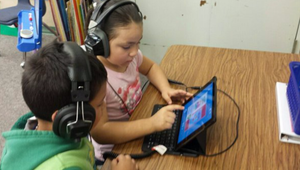
Educators sometimes mistakenly assume that silence equals listening. Whether they are in the front of a classroom or leading a staff meeting, learning facilitators scan the room and smile if the learners sitting in the room are quiet and compliant. But how do we know that our message was heard? As a student, I became quite skilled at pretending I was listening, while all the while I was lost in an imaginative world. I would make eye contact and nod, but my mind was somewhere else. The moment I heard the inflection in a teacher’s voice indicating that they were asking a question, I would break eye contact so as not to be called upon to answer.
Some teachers insist that their students are listening because they take notes during a lecture. This is a step up toward active listening. It is valuable that learners produce something to synthesize their thinking. As students document their thinking, it helps to cement learning and provides invaluable information that educators can use to spot misconceptions and adjust instruction to meet student needs. But we must be careful about the way students “take notes”. If students are taking notes by filling out a premade study guide or graphic organizer during a lecture or video, or worse, merely copying an eductors’ powerpoint presentation, learners are not doing the thinking. The listening is not an active process.
What we often fail to realize is that listening is an active activity. It must be purposeful, with opportunities to interact. Whether a teacher with students or a professional learning facilitator, how might you ensure that your learners are prepared to listen to us, a video, or a peer? We begin by setting the stage. Do your students know the purpose of their listening? And do they know the methods through which they will be documenting their thinking?
Many educators provide a learning objective for students. An educator may say, “Today, you will watch a video to gain information you can use in your upcoming essay”. But it is even more powerful when the purpose comes from the students themselves. Lead a unit by presenting a problem to solve, or an overarching question that cannot be answered by Google. This prompts curiosity. It gives students purpose for listening. Ask students a “How might we” question. In a project based learning workshop I facilitated, educators worked collaboratively to create this question for their students, “How might we protect the natural habitat surrounding our school campus?” These educators then found videos about the needs of plants and animals native to the habitat. As students listen and watch the video, they have purpose. The purpose is not merely to memorize for an upcoming assessment, it is to gain information that will help them make a positive difference in their community.

I like to use the “How might we” strategy in professional learning sessions as well. In a recent workshop, I asked educators “How might we empower students to engage in meaningful cross-curricular activities?” I then sparked curiosity by asking educators themselves what they needed to know in order to answer this question. Educators shared their thoughts via an interactive Padlet. For the remainder of the workshop, educators had a reason to continue to listen to the message. They began with wonder and purpose. And best of all, the purpose came from the learners themselves, not from me. As a learning facilitator, the learners’ responses on the padlet were invaluable. If I am not aware of the curiosities of the learners in my midst, I cannot adapt my message to meet their needs. The need to know strategy is backed by the neuroscience of Universal Design for Learning. We activate the affective network of the brain when learners themselves set goals. The need to know strategy essentially prompts learners to identify and express their learning goals for answering a question.

Our learners also need to know how they will be expected to respond to the message they hear. And we activate both the affective and strategic networks of the brain when we provide students with choice as to ways in which they demonstrate learning. Rather than asking students to complete a teacher created worksheet while or after a listening activity, celebrate the variability of your students. The more open-ended the task, the better the opportunity for learners to reveal their unique genius.
What does this look like in practice?

Before students listen to an audiobook, prompt curiosity by asking them what they want to learn about the content (informational text), or what they wonder about the characters in the story (narrative text). After students listen to the book, allow them to synthesize their thoughts via a flipgrid, quick sketch, or tweet sized response.
The response to a listening activity need not always occur at the end, it can be done throughout. Adam Juarez, tech coach and high school history teacher, screencasts lessons (this personalizes learning and allows students to “rewind” the message). Students listen to the lessons and respond using various modes such as his “hashtag learning” strategy, sketchnotes, or flipgrid responses. Another great listening activity is to read a picture book or poem aloud and encourage students to draw what they hear. My primary aged students loved this strategy when I was a classroom teacher. While the story I read was typically a book with pictures, I did not show these images to my students. I wanted to spark their imagination, to prompt conversations between students as they compared and contrasted their interpretation of the text.
Are your learners listening? Leverage neuroscience. Prompt curiosity to empower students to own the learning, and always provide students multiple methods to express their thinking.
